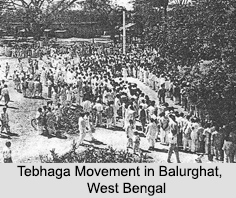 Tebhaga Movement was an important agitation of peasants, which was initiated in Bengal in 1946-47 by the Kisan Sabha. At that time, sharecroppers had to give half of their harvest to the landlords, which was demanded to reduce to one-third in the movement. In many areas of Bengal, this movement was turned into a violence as a result of which many landlords escaped from there, leaving their parts of the countryside in the hands of the Kisan Sabha.
Tebhaga Movement was an important agitation of peasants, which was initiated in Bengal in 1946-47 by the Kisan Sabha. At that time, sharecroppers had to give half of their harvest to the landlords, which was demanded to reduce to one-third in the movement. In many areas of Bengal, this movement was turned into a violence as a result of which many landlords escaped from there, leaving their parts of the countryside in the hands of the Kisan Sabha.
Outcome of Tebhaga Movement
In the year 1946, the sharecroppers started to make it clear that they would only pay one-third to the landlords and crops would stay in their own godowns before the division. Tebhaga Movement even created clashes between the Jotedars and Bargadars (sharecroppers).
As a response to the movement, the Muslim League ministry also launched a Bargadari Act, which supported the demand of giving one-third of the harvest to the landlords. The Bengal Land Revenue Commission or Floud Commission also recommended in favour of the sharecroppers. Though after all this, the law was not fully implemented.
Leaders of Tebhaga Movement
Some of the leaders of Tebhaga Movement are:
Ila Mitra
Kansari Halder
Moni Singh
Bishnu Chattopadhyay
M.A. Rasul
Moni Guha
Charu Majumdar
Abani Lahiri
Gurudas Talukdar
Samar Ganguly
Bimola Mandal
Sudher Mukherjee
Sudipa Sen
Moni Krishna Sen
Subodh Roy
Budi ma



















